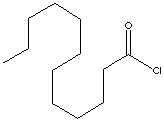PRODUCT IDENTIFICATION

H.S. CODE
TOXICITY
CLASSIFICATION
PHYSICAL AND CHEMICAL PROPERTIES
145 C at 15 hPa
REFRACTIVE INDEX
140 C
APPLICATIONS
APPEARANCE
98.0% min
ACIDITY
1.0% max (Lauric Acid)
|
|
|
| LAUROYL CHLORIDE | ||
|
PRODUCT IDENTIFICATION |
||
| CAS NO. | 112-16-3 |
|
| EINECS NO. | 203-941-7 | |
| FORMULA | CH3(CH2)10COCl | |
| MOL WT. | 218.77 | |
|
H.S. CODE |
2915.90 | |
|
TOXICITY |
||
| SYNONYMS | Dodecanoyl Chloride; Dodecanoic acid Chloride; | |
| n-Dodecanoyl chloride; Lauric acid, chloride | ||
| SMILES |
|
|
|
CLASSIFICATION |
||
|
PHYSICAL AND CHEMICAL PROPERTIES |
||
| PHYSICAL STATE | clear to slightly yellow liquid | |
| MELTING POINT | -12 C | |
| BOILING POINT |
145 C at 15 hPa | |
| SPECIFIC GRAVITY | 0.921 - 0.923 | |
| SOLUBILITY IN WATER | Decomposes | |
| pH | ||
| VAPOR DENSITY |
| |
| AUTOIGNITION | ||
|
REFRACTIVE INDEX |
1.4459 | |
| NFPA RATINGS | Health: 3; Flammability: 0; Reactivity: 0 | |
| FLASH POINT |
140 C | |
| STABILITY | Stable under ordinary conditions | |
|
APPLICATIONS |
||
| Acyl is a radical formed from an organic acid by removal of a hydroxyl group. The general formula of acyl compound is RCO-. Acyl halide is one of a large group of organic substances containing the halocarbonyl group, have the general formula RCO·X, where X is a halogen atom (fluorine, chlorine, bromine, iodine, and astatine) and R may be aliphatic, alicyclic, aromatic, and H etc. In substitutive chemical nomenclature, their names are formed by adding '-oyl' as a suffix to the name of the parent compound; ethanoyl chloride, CH3COCl, is an example. The terms acyl and aroyl halides refer to aliphatic or aromatic derivatives, respectively. Acyl halides are made by replacing the -OH group in carboxylic acids by halogen using halogenating agents. They react readily with water, alcohols, and amines and are widely used in organic synthetic process whereby the acyl group is incorporated into the target molecules by substitution of addition-elimination sequence called acylation reaction. Acylation reaction involves substitution by an electron donor (nucleophile) at the electrophilic carbonyl group (C=O). Common nucleophiles in the acylation reaction are aliphatic and aromatic alcohols, both of which give rise to esters and amines (RNH2) which give amides. The carboxylic acid (X = OH) itself can function as an acylating agent when it is protonated by a strong acid catalyst as in the direct esterification of an alcohol. Two common acylation agents, with the general formula RCOX, are acid halides (X = halogen atom) and anhydrides (X = OCOR). Schotten-Baumann reaction is an acylation reaction that uses an acid chloride in the presence of dilute alkali to acylate the hydroxyl and amino group of organic compounds. There are also other acylating agents. Lauroyl chloride C-12 fatty acyl halide, is a clear, corrosive liquid; melts at -12 C; , refractive Index of 1.4459. It reacts with water; soluble in common aprotic organic solvents including ether, acetone, and acetic acid. It is used making aroma compounds, surfactants, pesticides pharmaceuticals and other organic compounds such as textile auxiliaries, emulsifiers. | ||
| SALES SPECIFICATION | ||
|
APPEARANCE |
clear to slightly yellow liquid | |
| ASSAY |
98.0% min |
|
|
ACIDITY |
1.0% max (Lauric Acid) |
|
| TRANSPORTATION | ||
| PACKING | 190kgs in drum | |
| HAZARD CLASS | 8 (Packing group II) | |
| UN NO. | 3265 | |
| OTHER INFORMATION | ||
| Hazard Symbols: C, Risk Phrases: 34, Safety Phrases: 36/37/38 | ||
| PRICES | ||
|
|
|